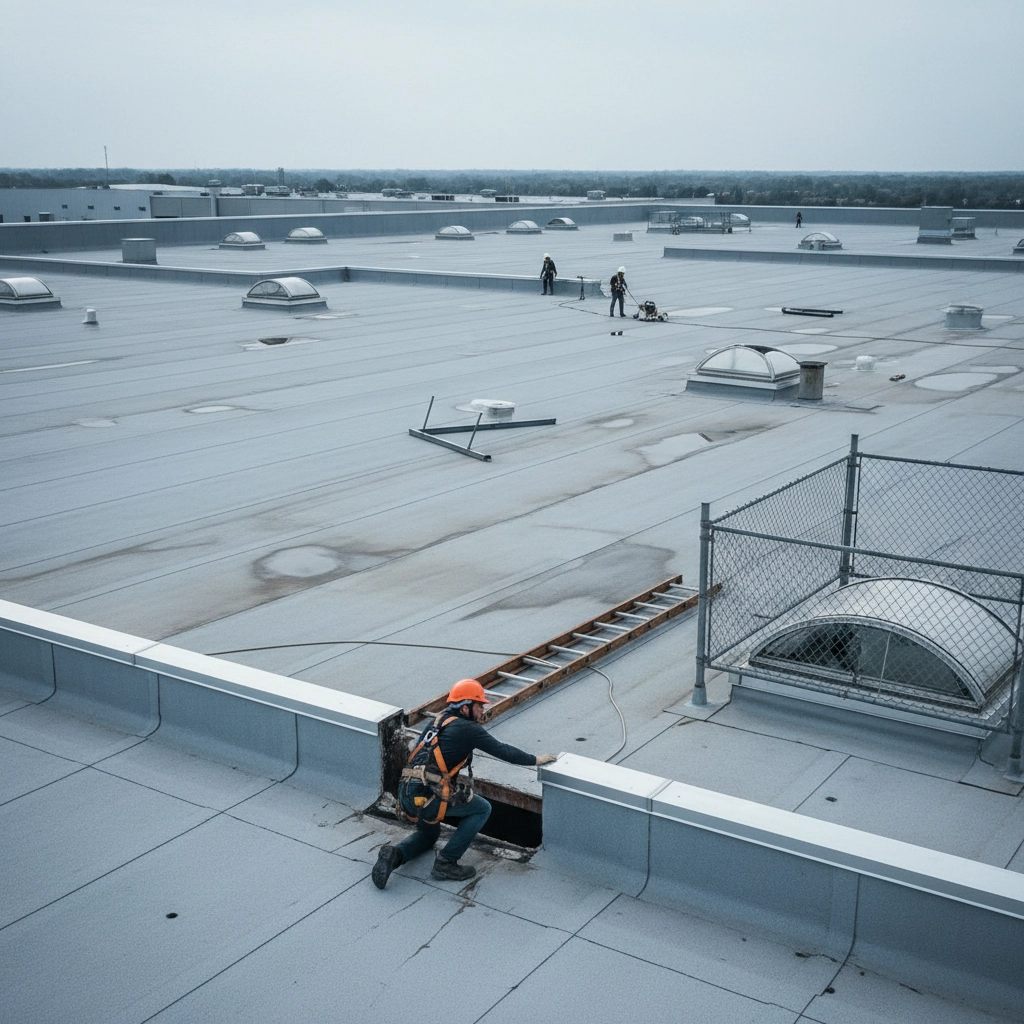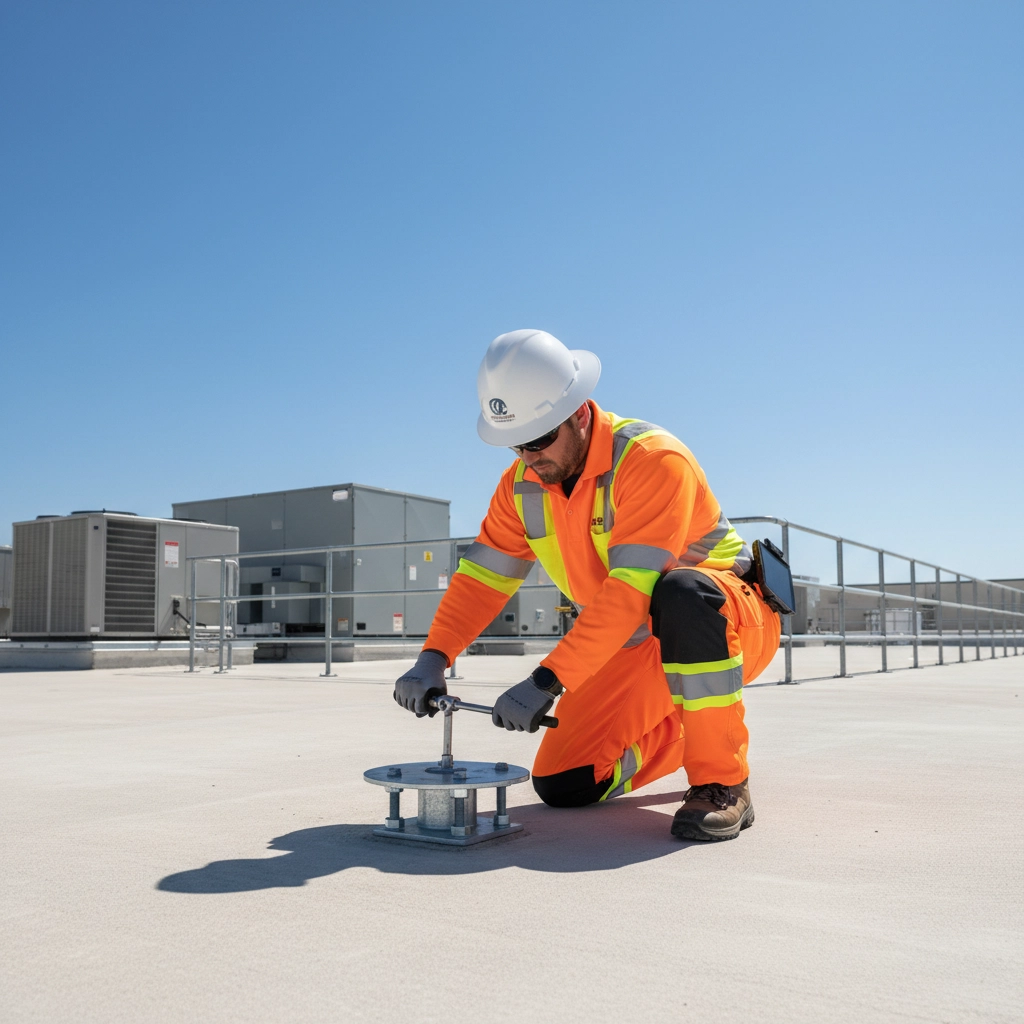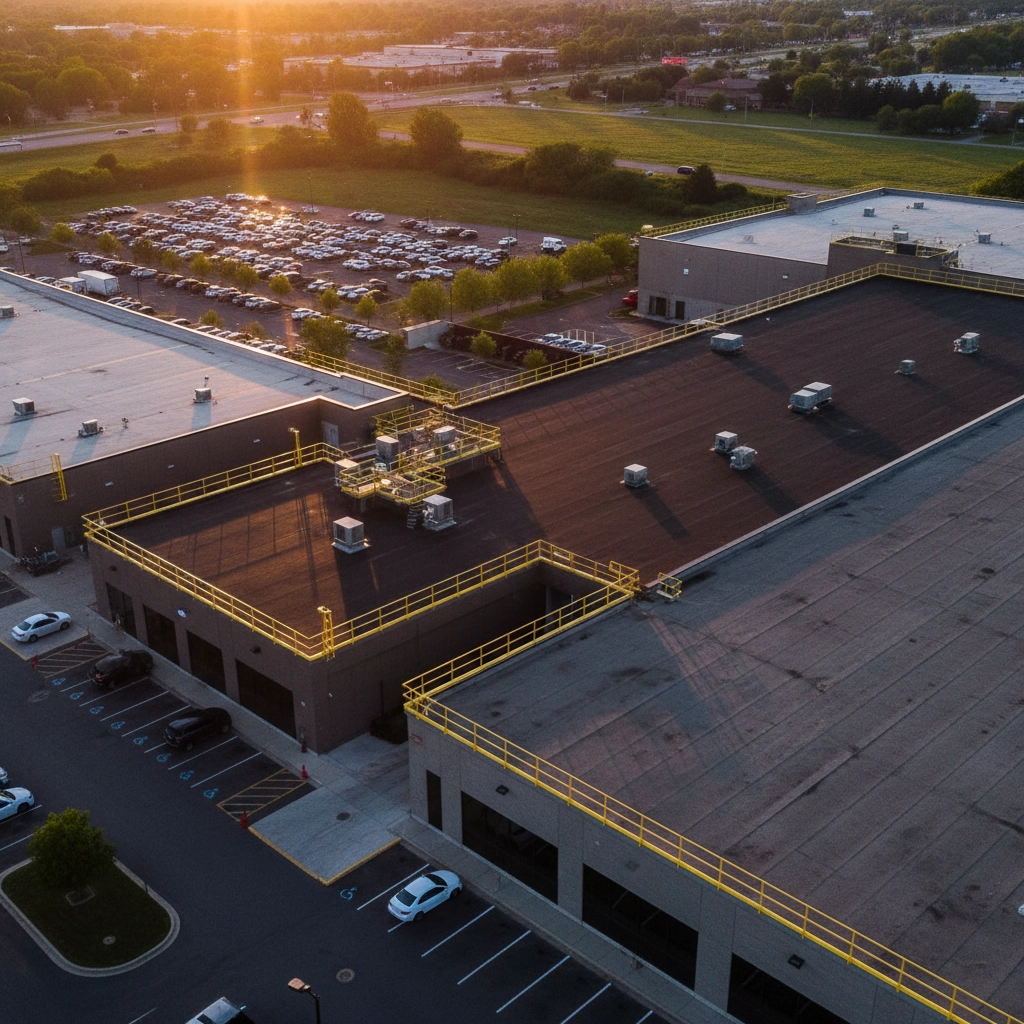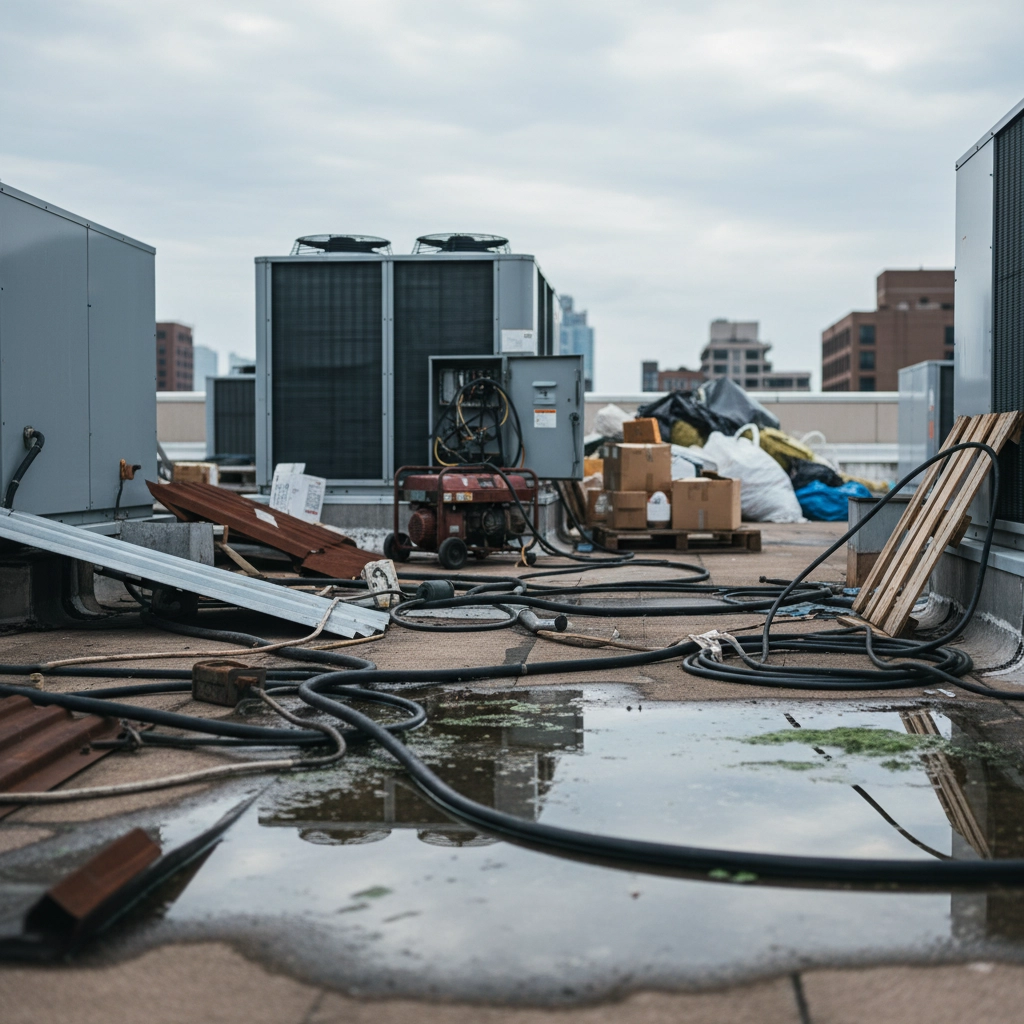
When was the last time you walked your commercial roof with OSHA compliance in mind? If you're like most facility directors and property managers, the answer is probably "never" – and that's a costly mistake waiting to happen.
OSHA violations for roofing safety can range from $15,625 for serious violations to over $156,259 for willful or repeated violations. But the real cost isn't just the fines – it's the potential for workplace injuries, lawsuits, increased insurance premiums, and the devastating impact on your team's morale and productivity.
Here's the reality: most commercial building owners assume their roofs are "safe enough" because they haven't had any accidents yet. That couldn't be further from the truth. OSHA inspectors routinely find the same overlooked safety hazards across thousands of commercial properties in Texas and Oklahoma, and these violations are entirely preventable with the right knowledge and approach.
Before we dive into the specific risks, let's get clear on what OSHA actually requires for commercial roofing safety. The Occupational Safety and Health Administration doesn't mess around when it comes to fall protection – and for good reason. Falls from height account for over 350 workplace deaths annually, with many more resulting in permanent disabilities.
OSHA's general industry standards (29 CFR 1910) and construction standards (29 CFR 1926) establish clear requirements for any work performed on commercial roofs. Here's what you need to know:
Fall Protection Requirements: Any work performed at heights of 6 feet or more (in construction) or 4 feet or more (in general industry) requires fall protection systems. Since virtually all commercial roofs exceed these heights, fall protection is mandatory for any rooftop access.
Acceptable Fall Protection Methods: OSHA allows four main types of fall protection systems:
Equipment Inspection Requirements: All fall protection equipment must be inspected before each use and after any incident that could affect its integrity. This includes ladders, scaffolds, personal protective equipment, and permanent roof safety systems.
Access Requirements: Safe access to and from work areas must be provided, including properly designed ladders, stairs, or access platforms that meet OSHA specifications.
Think of OSHA compliance like the oil changes for your fleet vehicles – it's not optional maintenance, it's mandatory protection that prevents catastrophic failures down the road.

After conducting hundreds of roof safety assessments across Texas and Oklahoma, we've identified five critical hazards that building owners consistently miss. These aren't obscure technical violations – they're fundamental safety gaps that create immediate liability and put people at serious risk.
This seems obvious, but unguarded roof edges remain the #1 overlooked hazard on commercial properties. We're not talking about obvious cliff-like drops – we're talking about seemingly minor elevation changes, parapet walls under 42 inches high, and areas where roofing meets lower structures.
Here's what makes this particularly dangerous: maintenance workers, HVAC contractors, and inspection crews need regular access to roof perimeters to service equipment, clear drains, and perform routine maintenance. Without proper guardrails or fall protection anchor points, every routine task becomes a life-threatening activity.
Scenario: Imagine a facilities manager in Fort Worth overseeing routine HVAC maintenance on their building’s roof. During the service, one of the contractors slips near an unprotected roof edge—just inches from a serious fall. The close call prompts an OSHA inspection, uncovering several safety violations. In this scenario, the result could easily be over $45,000 in fines, not to mention the unexpected cost of installing compliant fall protection after the fact.
What Constitutes Proper Edge Protection:
The second most common violation we encounter involves poorly designed access routes to rooftops. Building owners often focus on the roofing system itself while completely overlooking how people actually get onto the roof safely.
Common Access Violations Include:
Scenario:
Picture a warehouse in Dallas where the only roof access is a fixed ladder that leads to a spot less than three feet from an unprotected edge. Each time someone climbs onto the roof, they’re instantly exposed to a fall hazard. In this scenario, the facility manager isn’t aware that this setup violates multiple OSHA standards—until a professional roof safety assessment brings it to light.
Compliant Access Requirements:

This is where facility managers often get blindsided. While focused on preventing falls from height, they overlook the "same-level" fall hazards that can be just as dangerous when they occur on a rooftop.
Hidden Trip Hazards Include:
Think about this: a simple trip that would result in scraped knees at ground level can become fatal when it happens near an unprotected roof edge. We've seen facilities where routine HVAC maintenance required workers to navigate obstacle courses of pipes, conduits, and equipment with zero regard for safe walkways.
Creating Safe Walking Surfaces:
Here's where things get technical, and where many building owners make expensive mistakes. Having fall protection equipment isn't the same as having compliant fall protection equipment. OSHA requires that all fall protection systems be designed and installed by qualified persons, and many building owners discover their systems don't meet standards only after an incident or inspection.
Common Equipment Violations:
Scenario:
Imagine a property management company that believes their rooftop safety anchors are compliant and ready for use. During an inspection, it’s discovered that those anchors are fastened to lightweight roof decking that can’t handle the required loads. In this scenario, the entire system provides a dangerous false sense of security—appearing safe while actually putting anyone who ties off at serious risk.
Proper Fall Protection Systems Require:

The fifth and perhaps most critical overlooked risk is human behavior – specifically, the assumption that people know how to work safely on rooftops without proper training and documentation.
OSHA doesn't just require safety equipment; it requires competent persons to oversee roof work and trained workers who understand how to use safety systems properly. This is where many facility managers get caught off guard, especially when dealing with multiple contractors and service providers throughout the year.
Training and Documentation Gaps:
Scenario:
Your HVAC contractor falls and is suspended by their fall arrest system. Do you have a rescue plan? Do you know how to get them down safely? OSHA requires that rescue procedures be in place wherever fall arrest systems are used – yet most building owners have never considered this requirement.
If you've been following our blog, you know that weather in the South significantly affects your roof in ways that building owners often underestimate. But extreme weather also dramatically increases the safety risks we've discussed.
High Winds: Texas and Oklahoma are known for sudden, powerful wind events that can make routine rooftop work extremely dangerous. Wind speeds that seem manageable at ground level can be significantly higher on rooftops, and sudden gusts can easily knock workers off balance.
Extreme Heat: Summer temperatures regularly exceed 100°F on Texas rooftops, creating heat exhaustion risks that impair judgment and reaction times. Workers suffering from heat stress are more likely to make safety mistakes or ignore proper procedures.
Severe Weather Events: Hail storms and high winds frequently damage roofing systems, creating urgent repair needs that can tempt building owners to cut corners on safety protocols. Post-storm rooftop conditions often include wet surfaces, damaged equipment, and debris that create additional hazards.
Ice and Snow: While less common, winter weather events can create extremely hazardous rooftop conditions that many southern building owners are unprepared to handle safely.

Let's talk numbers, because the financial impact of OSHA violations extends far beyond the initial fines. We've worked with building owners who thought they were saving money by avoiding safety investments – until they got hit with the real costs of non-compliance.
Direct OSHA Fines (as of 2024):
Indirect Costs (often 5-10 times higher than fines):
Scenario:
A distribution center in Oklahoma received $78,000 in OSHA fines for multiple rooftop safety violations. But the real cost was over $300,000 when factoring in legal fees, emergency safety system installations, increased insurance premiums, and lost productivity during the correction period.
Here's what facility managers often miss: insurance companies are increasingly requiring OSHA compliance documentation before approving claims related to rooftop incidents. A safety violation can void your coverage just when you need it most.
At TriVAN Roofing, we don't just install and maintain roofing systems – we help building owners create comprehensive roof safety programs that protect people and prevent violations. Here's how our approach differs from typical roofing contractors:
Comprehensive Safety Assessments: Every project begins with a thorough evaluation of existing safety systems, access points, and compliance gaps. We identify violations before OSHA does, giving you time to address issues properly rather than under emergency pressure.
Engineered Fall Protection Systems: Our team includes certified fall protection professionals who design anchor points, guardrail systems, and access solutions that meet or exceed OSHA requirements. We don't guess – we engineer solutions based on actual loads, environmental conditions, and specific use requirements.
Integrated Safety Planning: When we design preventive maintenance programs, safety access is built into every recommendation. We consider how technicians will safely reach equipment, perform inspections, and complete routine maintenance throughout the year.
Documentation and Training Support: We provide the documentation facility managers need to demonstrate OSHA compliance, including equipment specifications, inspection schedules, and maintenance protocols. We also connect building owners with qualified training providers for their specific needs.
Ongoing Compliance Monitoring: Safety isn't a one-time installation – it's an ongoing responsibility. Our maintenance programs include regular safety system inspections and updates to ensure continued compliance as regulations evolve.
Don't wait for an incident or inspection to address these issues. Here's your roadmap to creating a compliant, safe rooftop environment:
Step 1: Conduct a Comprehensive Safety Assessment
Schedule a professional evaluation of your current rooftop safety systems. This should include fall protection equipment, access points, walking surfaces, and documentation review. We highly suggest having this done by qualified professionals who understand both OSHA requirements and roofing systems.
Step 2: Address Immediate Hazards
Identify and correct any obvious safety violations that create immediate risks. This might include blocking access to unprotected areas, removing trip hazards, or posting warning signs until permanent solutions can be installed.
Step 3: Develop a Prioritized Improvement Plan
Not all safety issues need to be fixed simultaneously, but they all need to be addressed. Work with qualified professionals to create a timeline that addresses the most critical violations first while planning for comprehensive long-term compliance.
Step 4: Install Engineered Safety Systems
Invest in properly designed fall protection systems that meet OSHA requirements for your specific building and use patterns. This isn't a DIY project – use certified professionals who can provide documentation and warranties for their installations.
Step 5: Establish Training and Documentation Protocols
Ensure that everyone who accesses your roof understands safety requirements and proper equipment use. This includes your staff, contractors, and service providers. Document all training, equipment inspections, and maintenance activities.
Step 6: Create Emergency Response Procedures
Develop and practice rescue procedures for fall arrest situations. Make sure designated personnel know how to respond to rooftop emergencies and have the equipment and training necessary to help fallen workers safely.
Step 7: Schedule Regular Compliance Reviews
OSHA requirements evolve, equipment ages, and building conditions change. Schedule annual safety assessments to ensure continued compliance and address any new hazards or requirements.

Here's something many facility managers overlook: when contractors work on your roof, their safety violations can become your liability. OSHA holds building owners responsible for providing safe working conditions, even for contractor employees.
Contractor Safety Requirements:
Red Flags to Watch For:
Remember, "that's how we've always done it" isn't a valid defense when OSHA comes knocking. Industry practices that were acceptable 10 years ago may violate current standards, and ignorance of requirements doesn't reduce your liability.
Not all commercial roofs present the same safety challenges. Here's what facility managers need to know about specific building types:
Manufacturing and Industrial Facilities: Often have complex rooftop equipment layouts that create unique access challenges. Heavy machinery and process equipment may require specialized anchor points and walkway systems.
Retail and Office Buildings: Typically have simpler rooftop layouts but may lack adequate access points for routine maintenance. HVAC equipment placement often creates fall hazards that weren't considered during initial construction.
Schools and Institutional Buildings: Have additional liability concerns due to potential public access and higher safety scrutiny. Emergency evacuation procedures may require specialized rooftop safety considerations.
Warehouses and Distribution Centers: Large roof areas with minimal equipment can create complacency about safety systems. Long distances between access points and equipment often require comprehensive fall protection coverage.
Here's what many facility managers don't realize: comprehensive rooftop safety programs actually save money and improve operational efficiency. When your building has proper safety systems, contractors can work more efficiently, maintenance costs decrease due to better access, and you avoid the emergency expenses that come with safety violations.
Think of it this way: would you rather invest in planned safety improvements on your timeline and budget, or pay for emergency corrections under OSHA pressure at premium prices?
Companies with strong safety programs also find it easier to attract and retain quality contractors. The best roofing and maintenance professionals want to work on properties where they feel safe and protected. They're also more likely to provide competitive pricing when they don't have to factor safety risks into their bids.
OSHA compliance for commercial rooftops is complex, technical, and constantly evolving. The risks we've discussed aren't just regulatory concerns – they're serious threats to the safety of everyone who works on or around your building.
You're not in this alone. At TriVAN Roofing, we've helped hundreds of facility managers across Texas and Oklahoma create comprehensive rooftop safety programs that protect people and prevent violations. Our team includes certified safety professionals who understand both OSHA requirements and practical roofing operations.
Whether you need a complete safety system overhaul or just want to verify your current compliance status, we're here to help. Our safety assessments identify specific violations and provide clear, prioritized recommendations for creating a compliant, safe rooftop environment.